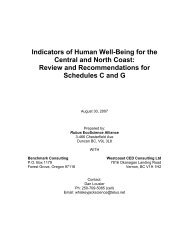Northern Plan Area Economic Opportunities and Barriers Study
Northern Plan Area Economic Opportunities and Barriers Study
Northern Plan Area Economic Opportunities and Barriers Study
You also want an ePaper? Increase the reach of your titles
YUMPU automatically turns print PDFs into web optimized ePapers that Google loves.
Hecate Lowl<strong>and</strong>s<br />
Dawsons L<strong>and</strong>ing:<br />
Here there is a public wharf with a DFO float. Post office <strong>and</strong> a well equipped general<br />
store. Charts, water, ice, gas, diesel <strong>and</strong> other products are available. It is a service<br />
center for marine tourism <strong>and</strong> the commercial fisheries.<br />
The Evolution of <strong>Economic</strong> Development in the Hecate Lowl<strong>and</strong>s:<br />
Historically First Nation populations inhabited the Hecate Lowl<strong>and</strong>s year round. The<br />
availability of food allowed native communities to remain stable <strong>and</strong> healthy. Villages<br />
were well established <strong>and</strong> evolved to accommodate food gathering <strong>and</strong> weather. Reserves<br />
were not designed to integrate the relationship to food gathering <strong>and</strong> seasonal<br />
communities.<br />
The early 1900s brought the development of canneries to the Hecate Lowl<strong>and</strong>s. This<br />
provided seasonal employment in both fishing <strong>and</strong> processing. By the 1970s larger boats<br />
with refrigeration units made it possible for fish processing to become centralized <strong>and</strong><br />
coastal canneries closed. The closure of the canneries resulted in the collapse of central<br />
coast employment in many communities.<br />
By the 1950s there was an increased interest in the area for sport fishing. Some old<br />
canneries were converted into sport fishing lodges, <strong>and</strong> with the help of American<br />
celebrities such as John Wayne the Hecate Strait was promoted as an ideal location for<br />
catching “trophy fish”. By the 1980s this area offered some of the best fishing in the<br />
world. These fishing lodges target a high-end clientele who pre-book holidays.<br />
Community development <strong>and</strong> expansion into the service industry for the centralized<br />
fishing fleet, especially in marine repairs <strong>and</strong> fuel also brought an increase in marine<br />
tourism.<br />
The economic value of forest harvesting in the Hecate Lowl<strong>and</strong>s has been considered<br />
lower than other areas within the plan <strong>and</strong> there has been no commercial gathering of<br />
botanicals.<br />
There are guide outfitters <strong>and</strong> trappers licensed in the Hecate Lowl<strong>and</strong>s. The target<br />
species for the guide outfitters are black bear, grizzly bear, <strong>and</strong> goat. Local residents<br />
have historically trapped; however, it is on the decline.<br />
Mineral exploration occurred in the 1930s, <strong>and</strong> a gold mine was opened at Surf Inlet, but<br />
operations ended with the start of World War II. Post war activity was limited to a<br />
limestone quarry, which provided flux to Ocean Falls. This was closed down when the<br />
Ocean Falls’ pulp mill closed. A limestone quarry on Aristazabal is becoming active.<br />
The only other mining activity in the Hecate Lowl<strong>and</strong>s was for clay.<br />
15

















